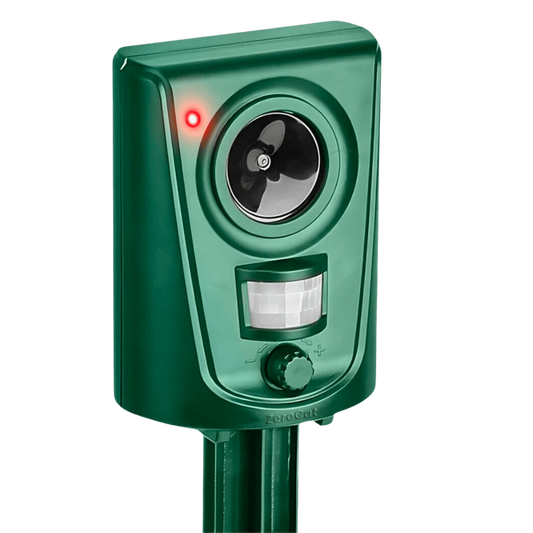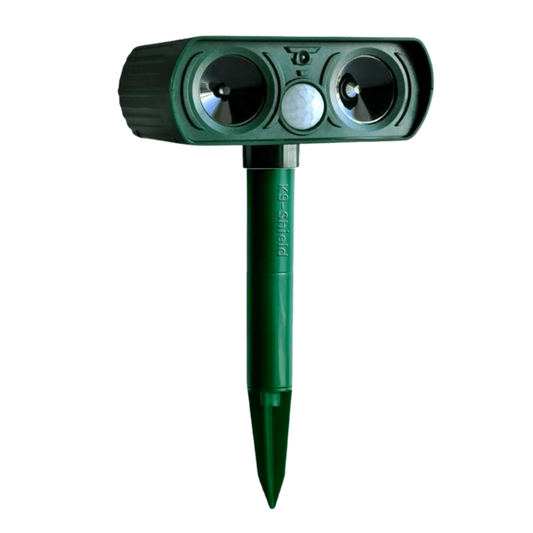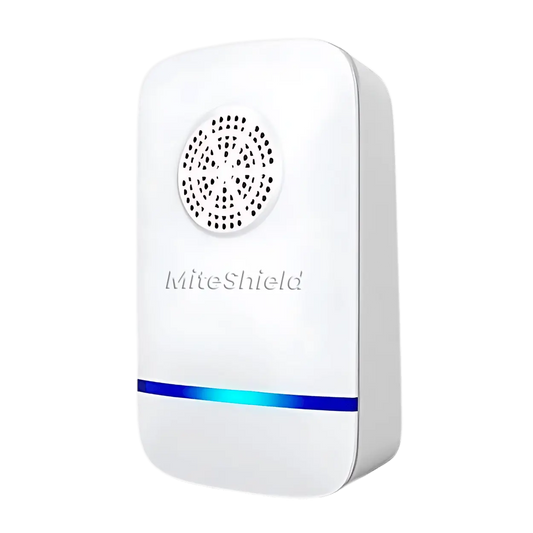Tired of finding paw prints, dug-up flower beds, or worse, surprises on your lawn? Whether it’s your neighbor’s dog or a stray, having dogs run loose in your yard can quickly become a frustrating problem. Fortunately, there are proven, humane ways to repel them. In this guide, you'll discover the most effective methods to repel dogs from your yard: naturally, safely, and for good.
Common reasons dogs enter your yard
Before choosing the right repellent, it's important to understand why dogs are drawn to your yard in the first place. Once you know the cause, you can choose a solution that targets the behavior at its source, not just the symptoms.
One of the most common reasons is scent. If you’ve recently barbecued, used organic fertilizers, or have trash cans that aren’t tightly sealed, the smells can be irresistible to a dog’s powerful nose. Even pet urine from other animals can mark your yard as a popular stop.
Open spaces and soft soil also attract dogs, especially those looking for a place to dig or relieve themselves. If your garden is not fenced or your gate is frequently open, curious pups may see it as an invitation to explore.
Another reason could be existing pets or wildlife. Dogs are naturally curious and might chase after cats, squirrels, or birds they spot in your yard.
And finally, some dogs just pass through out of habit. Once a dog gets used to cutting across your lawn or visiting regularly, it can quickly become part of their routine, unless you intervene.
Why should you keep dogs out of your yard?
Giving dogs open access to your yard might seem harmless at first, but it can lead to a range of problems. Here’s why it’s important to keep them out:
- Protect your garden: Dogs love to dig, trample plants, and sniff around, often leaving a trail of destruction behind.
- Prevent unpleasant surprises: Dog urine can damage grass and flowers, while feces can pose hygiene risks and attract flies or other pests.
- Avoid health hazards: Some dog waste can carry parasites or bacteria that may be harmful to humans, especially children playing outside.
- Keep your pets safe: If you have pets, unfamiliar dogs can provoke fights or spread diseases.
- Reduce unwanted noise and stress: Barking, chasing wildlife, or territorial behavior can disturb the peace in your home and stress your animals.
-
Preserve property value and appearance: A yard that’s clean and well-kept is not just more enjoyable. It also helps maintain your home’s curb appeal.
How to repel dogs from your yard naturally?
If you're looking for safe, eco-friendly ways to repel dogs, natural repellents are a great place to start. These methods rely on scents, plants, and simple household ingredients that dogs instinctively avoid. Let’s explore a few practical solutions you can apply right at home.
Plants that naturally deter dogs

Certain plants act as natural dog repellents thanks to their strong aroma or texture. You can use them to create borders or fill in trouble spots around your yard.
- Rue: Known for its strong smell and bitter taste, this plant is unpleasant to dogs and other animals.
- Lavender: Though pleasant to humans, many dogs dislike the potent fragrance.
- Coleus canina (also called “Scaredy Cat Plant”): Despite the name, it’s effective on dogs too due to its skunky scent.
- Citronella and lemongrass: Their citrusy oils are often used in repellents, and the plants themselves help deter dogs.
Using natural smells that dogs hate
A dog's sense of smell is extremely sensitive, which makes certain smells particularly effective at repelling dogs. Here are a few safe options you can sprinkle or spray around your yard:
- Vinegar: The sour smell is off-putting to dogs. Mix equal parts vinegar and water and spray it on surfaces where dogs frequent (avoid direct contact with plants).
- Citrus peels: Orange, lemon, or grapefruit peels scattered around the yard can act as a gentle deterrent.
- Coffee grounds: Used grounds have a strong smell that dogs dislike and also benefit your soil.
- Ammonia: Very effective, but use with caution—never spray directly on grass or plants.
Always test a small area first to ensure your chosen scent doesn’t damage your plants or soil. Because smells can fade fast, pairing them with an ultrasonic deterrent ensures your yard stays off-limits—even when you're not around.
Making DIY dog repellent

Want a homemade solution that’s both affordable and non-toxic? Try making your own dog deterrent spray:
Simple recipe:
- 1 cup of white vinegar
- 1 cup of water
- 2 tablespoons of lemon juice or peppermint oil
Mix in a spray bottle and apply it around entrances, flower beds, or known “hot spots.” Reapply after rain or watering.
For digging issues, try mixing cayenne pepper or mustard powder into the soil, but use with caution to avoid irritation.
These DIY methods are especially useful if you want to avoid harsh chemicals while still sending a clear “keep out” message to visiting pups.
Physical barriers that repel dogs
Natural methods work well, but sometimes, you need a more direct way to block access, especially if dogs are persistent visitors. Physical barriers offer a reliable, long-term solution to keep them out of your yard without causing harm. Here are the most effective options to consider.
Fences (Traditional or Electric)

A good old-fashioned fence remains one of the most effective ways to keep dogs out. A wooden or vinyl fence that's at least 4 to 6 feet tall can discourage most jumpers and diggers. Make sure there are no gaps underneath where smaller dogs can squeeze through. If you’re dealing with especially stubborn dogs or live in a rural area, low-voltage electric fences (specifically pet-safe models) can create an invisible boundary. They’re often used in combination with training collars and should always be used responsibly, following the manufacturer's instructions.
Chicken wire or mesh

If dogs are digging under your fence or targeting specific garden spots, burying chicken wire or metal mesh a few inches below the soil can be surprisingly effective. The uncomfortable texture under their paws discourages them from continuing to dig. You can also lay mesh flat across flowerbeds and cover it lightly with mulch to protect plants while deterring intrusion.
Motion-activated sprinklers
These clever devices detect movement and instantly spray a short burst of water. Most dogs dislike sudden water jets, and the surprise factor is often enough to stop them from coming back. They’re also eco-friendly and double as watering tools for your garden. For best results, position them along common entry points or problem areas. If you're looking for a reliable device, consider the JetSentinel Water Sprinkler Animal Repellent by Sonic Barrier. Built for consistent performance, it combines quick-response motion sensors with a safe water deterrent, making it ideal for driveways, gardens, and patios where dogs tend to sneak in.
Plastic or Metal Spikes

Don't worry—these aren’t harmful. Plastic or metal spike strips (also called “anti-climb strips”) are designed to feel uncomfortable underfoot without injuring the dog. You can place them on top of fences, along walls, or even on the ground in narrow walkways. They create a physical and sensory barrier that makes your yard far less appealing to explore.
Commercial solutions to repel dogs from your yard
If natural or physical methods aren’t enough, or you’re looking for quicker, ready-to-use options, there are many commercial products designed specifically to deter dogs. These tools are safe, effective, and often easy to install or apply, making them ideal for homeowners who want peace of mind without constant maintenance.
Ultrasonic dog repellents
Ultrasonic repellents work by emitting high-frequency sound waves that are unpleasant to dogs but inaudible to most humans. These devices are usually motion-activated, triggering a burst of ultrasonic sound when a dog enters the detection zone. Most dogs quickly associate the noise with the location and learn to avoid the area. They’re best placed at entry points, near garbage bins, or along fences. For outdoor use, make sure to choose a weather-resistant model like the K9 Shield outdoor dog repellent of Sonic Barrier with adjustable frequency settings. It is actually one of the best ultrasonic dog repellents on the market. If you're looking for user feedback before buying, feel free to check out our review of ultrasonic dog repellents, where we detail their advantages, limitations, and usage tips.
Scent-based dog repellent sprays and granules
Commercial repellent sprays and granules are formulated with scents that dogs instinctively avoid, like citronella, eucalyptus, mustard, or capsaicin. You can spray them directly on surfaces, fences, or plants (as long as the product is plant-safe), or sprinkle granules around garden beds, pathways, or trash bins. Many of these products are biodegradable and pet-safe, but they do require regular reapplication, especially after rain.
Dog deterrent mats
These mats are textured with soft spikes or ridges that feel uncomfortable under a dog’s paws without causing pain. They’re especially useful for flat surfaces, like patios, decks, porch steps, or specific areas in the yard you want to block off. Some models are also embedded with scents or visual deterrents to enhance their effect. Simply place them where dogs tend to walk, dig, or settle, and most will learn to steer clear after a few tries.
Tips to prevent dogs from coming back
Once you’ve successfully repelled dogs from your yard, the key is keeping them away for good. Deterrents work best when combined with habits that make your yard consistently uninviting to dogs. Here are a few practical tips to help you maintain a dog-free space over time:
- Get rid of leftover smells: Dogs have an excellent memory for smells. Wash away urine spots, feces, or old food scraps using an enzymatic cleaner to eliminate the scent trail that might attract them again.
- Keep your yard clean and tidy: Secure your trash bins with tight-fitting lids, avoid leaving pet food outdoors, and remove fallen fruits or compost that could tempt a curious nose.
- Close off access points: Regularly inspect your fences and gates for gaps or loose panels. If there’s an easy entryway, dogs will find it—and remember it.
- Rotate repellents: Dogs can sometimes get used to a single scent or method. Switching between natural and commercial repellents every few weeks can keep the deterrent effect strong.
- Establish boundaries: If the same dog keeps returning, consider gently speaking with the owner (if known) or using humane deterrents like our ultrasonic dog repellent or sprinklers near the entrance points.
When everything else fails, this one works—no chemicals, no noise, just results.
What not to do when repelling dogs
While it’s understandable to feel frustrated when dogs repeatedly enter your yard, it’s crucial to use safe, humane, and legal methods to keep them out. Some approaches might seem effective at first but can do more harm than good or even get you into trouble. Here’s what to avoid:
- Don’t use harmful substances: Avoid using chemicals like bleach, mothballs, or ammonia in high concentrations. These are toxic and can cause serious injury to dogs, other animals, and even children playing in your yard.
- Don’t rely on aggression: Yelling, throwing objects, or physically confronting a dog can escalate the situation and provoke defensive or fearful behavior. It also risks damaging your relationship with neighbors.
- Don’t use traps or painful deterrents: Spiked barriers designed to injure, electric shock devices, or poisons are not only inhumane but illegal in many areas. They can lead to severe consequences, both ethically and legally.
- Don’t neglect regular maintenance: Even the best deterrents fail if you don’t reapply sprays, fix broken fences, or clean up attractive scents. Set a routine to check your yard and maintain your chosen methods.
- Don’t forget local laws: If you live in a neighborhood or community with pet regulations, familiarize yourself with what you’re allowed to do. It’s always better to stay within legal boundaries while protecting your space.
FAQ
When should you start taking steps to repel dogs from your yard?
You should take action as soon as you notice signs of dogs entering your yard. Don’t wait for the problem to escalate. The earlier you intervene, the easier it is to break the habit. Whether it’s paw prints, dug-up soil, chewed plants, or droppings, these are clear indicators that a dog has made your yard part of their routine. Acting early helps prevent further damage and discourages repeat visits. If the behavior continues unchecked, dogs are more likely to return frequently or even mark the area, making it harder to reverse. Start with simple steps like removing attractive smells or closing gaps, then move on to stronger deterrents as needed. A proactive approach always yields better long-term results than waiting for the problem to become chronic.
How to choose the most effective method to repel dogs from your yard?
Choosing the right method depends on the root cause of the dog’s behavior, your yard layout, and your personal preferences. Start by identifying why the dog is entering your space: Is it curiosity? Food smells? An open path? If it’s scent-related, natural or commercial smell-based deterrents may do the trick. If the dog is digging or physically entering, physical barriers like fences or mesh might be necessary. Also consider your environment, urban yards may benefit from ultrasonic devices like K9 Shield, while rural areas might need stronger perimeter protection. Opt for humane, safe, and pet-friendly solutions, especially if you have your own animals or children. Many homeowners find that combining multiple methods like a motion-activated sprinkler plus scent repellent offers the best results. Keep testing until you find the mix that works for your situation.
Which natural solutions work best to repel dogs from your yard?
Natural repellents are a great first line of defense, especially if you want to avoid chemicals or harsh products. The most effective ones usually target a dog’s strong sense of smell. Citrus peels, white vinegar, coffee grounds, and essential oils like eucalyptus or citronella can be sprinkled or sprayed around entry points and garden beds. Certain plants also work well as living deterrents (rue, lavender, and Coleus canina) emit odors that dogs naturally avoid. For diggers, placing cayenne pepper or mustard powder in the soil (carefully and in small amounts) can stop the behavior without harm. These methods are best for light to moderate problems and work even better when paired with physical deterrents. Just keep in mind that natural methods require regular upkeep and may need to be rotated to stay effective.
What is the most reliable physical barrier to repel dogs from your yard?
The most reliable physical barrier is a solid, well-installed fence, especially one that’s at least 4 to 6 feet high with no gaps underneath. It creates a clear boundary and removes easy access altogether. If installing a fence isn’t an option, chicken wire or buried mesh along the base of existing fences can stop digging, while plastic or metal anti-climb strips can prevent jumping or climbing. Motion-activated sprinklers also act as both a deterrent and a psychological barrier, surprising the dog each time it approaches. For smaller areas like garden beds or patios, dog deterrent mats with soft spikes provide a physical discomfort that encourages avoidance. The most effective strategy often involves combining multiple barriers to address different behaviors: digging, jumping, and entering.
What’s the best commercial solution to repel dogs from your yard?
Among commercial products, ultrasonic dog repellents like K9 Shield are widely considered the most convenient and effective. They’re easy to install, require little maintenance, and work silently by emitting high-frequency sounds dogs dislike. Motion-activated models are particularly useful because they only trigger when needed, saving battery and reducing noise pollution. For scent-based options, repellent sprays and granules are a great choice, especially those made with natural ingredients like citronella, garlic, or pepper extracts. They’re safe for gardens and pets, but require regular application. Dog deterrent mats are also effective for blocking access to specific spots without harming the dog. The best product for you will depend on the layout of your yard, weather conditions, and whether the dogs are strays or neighbors’ pets. Choose a solution that fits your environment and combine it with good yard maintenance for lasting results.









